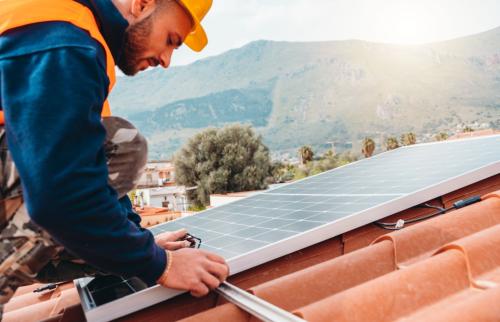The first episode of season two of Climate Sense, hosted by Samantha Gross, is all about hydrogen. Hydrogen will have an important role in a zero-carbon energy system, enabling decarbonization of energy end-uses that cannot easily use electricity. Hydrogen is made today by splitting molecules of either water or natural gas, using significant energy in the process, so it’s important to reserve hydrogen for its highest and best uses. However, future production of geologic hydrogen could be game-changing, giving us a zero-carbon fossil fuel.
- Listen to Climate Sense on Apple, Spotify, or wherever you like to get podcasts.
- Learn about other Brookings podcasts from the Brookings Podcast Network.
- Sign up for the podcasts newsletter for occasional updates on featured episodes and new shows.
- Send feedback email to [email protected].
TRANSCRIPT
[montage of news clips; music]
GROSS: We hear about climate change in the news all the time. Natural disasters like hurricanes and floods and heat waves are becoming more frequent. Scientists have predicted these outcomes as the global average temperature goes up. The forecast often sounds gloomy, and some young people have told me that they feel hopeless in the face of the changing climate. But this podcast is about solutions, not hopelessness.
I’m Samantha Gross. I’m the director of the Energy Security and Climate Change Initiative at the Brookings Institution and I’ve spent my career focused on energy and environmental issues. I’ve been in Washington for 20 years now, working on energy policy in government and private industry before I came to Brookings. But I started my career as an engineer, designing technical solutions to environmental problems. My work now focuses on how to transition to a clean, zero carbon energy system—the technical, political, and social challenges in getting from here to there.
In season one of Climate Sense, I focused on the basics of climate change and our energy system, walking listeners through some basic climate science, why we use fossil fuels, and the basics of sectors like electricity generation and transportation.
In season two of Climate Sense, I’ll focus on technical and political solutions to climate change. How can we reduce greenhouse gas emissions, motivate businesses and people to act, and pay for all the change we need? The situation is not hopeless at all, but we do need smart solutions; we need to focus on deploying the technologies we have and to pick the low-hanging fruit first. I’m an optimist by nature, and I look forward to sharing some of that optimism with you.
[music]
This first episode is about a substance that is getting a lot of attention: hydrogen. But there are a lot of misconceptions about where it comes from and what it’s good for. And to get us started, I welcome one of the smartest people I have the privilege to know.
MONIZ: I’m Ernie Moniz and I’m heading the Energy Futures Initiative. Prior to that, I was energy secretary. And prior to that, the founding director of the MIT Energy Initiative, which we think has been one of the most effective certainly of the university programs looking at both technology and policy for the clean energy transition.
GROSS: I’ve known Ernie since his days at MIT and worked for him for a bit when I was at the U.S. Department of Energy. In an episode last season, we covered how clean electricity and electrification are at the center of getting greenhouse gas emissions out of our energy system. But as Ernie points out, clean electricity won’t be able to do everything.
[3:42]
MONIZ: Hydrogen certainly has a tremendous amount of promise for a decarbonized energy economy going forward. Let me first say that clean electricity, low to no carbon electricity, is clearly very very central to our plans and that includes some further electrification of transportation, of space heating, et cetera, going forward.
However, just about everyone now has finally come to the conclusion that it’s not going to be enough. It is absolutely necessary, but it’s not going to be sufficient. We are going to need something that replaces carbon bearing fuels in the system. And hydrogen is certainly one of the most important pathways.
Hydrogen could be a pathway for decarbonizing industry, for example, making green steel without needing coke or coal. It could be a way of serving especially heavy transportation trucks. It could be a fuel for long distance shipping. It could be combined with carbon dioxide and sunlight to make new fuels, some so-called e-fuels. It could be used with turbines to make electricity. It could be used to serve buildings, or residential and commercial building. So, it could be extremely flexible in terms of end use.
GROSS: Hydrogen isn’t an all-purpose solution, but it’s a necessary part of our toolkit. Let’s learn more about it.
SATYAPAL: My name is Sunita Satyapal, and I’m the director for the U. S. Department of Energy’s Hydrogen and Fuel Cell Technologies Office, and also coordinate hydrogen activities across DOE and have various roles including coordination across agencies and have various international coordination roles as well.
GROSS: I asked Sunita to explain to us exactly what hydrogen is. We hear a lot about it, but it’s poorly understood by many people.
[5:55]
SATYAPAL: Hydrogen is an energy carrier, so it’s not an energy source. But in the simplest sense, hydrogen is a chemical element. Actually, it’s element one in the universe. It’s the lightest element. And under normal conditions it’s a gas. It is colorless, odorless, non-toxic. It’s obviously highly flammable as any fuel is. Most of the time it’s not available in free form. So, you do have to produce it.
And it can store energy and it has very high energy content. So, it actually has by weight three times more energy content than gasoline, but because it’s a gas also by volume, it does not have as much energy.
[music]
It can be used as a fuel, you can use it to make fertilizer, so ammonia, other chemicals.
GROSS: Hydrogen is a chemical part of substances we interact with every day. But the hydrogen we use in the energy system—hydrogen molecules—needs to be extracted from another substance; it doesn’t tend to appear on its own in nature. This always takes a lot of energy, but the greenhouse gas emissions vary depending on the process and where that energy comes from. Hydrogen is often described in terms of “colors” as shorthand for how its produced: blue, green, gray, and more. But it makes more sense to think in terms of greenhouse gas emissions, and that’s what we’ll do here.
[7:34]
MONIZ: What we need to of course get hydrogen. There are two, and maybe three, major sources. The two that are most talked about are first, methane, which is one carbon atom and four hydrogen atoms. And water, H2O, two hydrogen atoms and one oxygen atom.
And so, the first thing is can we shake the hydrogen off of the water or methane molecules? It takes far less energy to shake the hydrogen off a methane molecule than off of a water molecule. So, that’s an advantage for the methane route. But the methane route, you have to take care of that carbon. Whereas with the water route you can split it with electricity, so called electrolysis, and then you have hydrogen and oxygen and no carbon to worry about. So, it takes more energy but it’s immediately green, if you like, if the electricity is also carbon free that you were using.
GROSS: The carbon atom that comes from that molecule of methane gets combined with oxygen to make carbon dioxide, the most common greenhouse gas. So, even though making hydrogen from methane uses less energy, dealing with the carbon dioxide that comes from the process also requires energy. Or that carbon dioxide is released to the atmosphere.
[9:02]
MONIZ: There is a third pathway that is beginning to get a lot more attention, but we don’t know the answer yet whether it will have sufficient scale, and that is called geological hydrogen. Hydrogen, we believe, is certainly continuously generated within the Earth, but up until now it’s always been viewed that hydrogen just kind of, you know, diffuses out of the earth into the atmosphere and may not be economically useful.
[music]
GROSS: We’ll come back to that last potential source of hydrogen at the end of our discussion.
So, we’ve established what hydrogen is and how we might produce it. The next place to go is the pathway—how do we establish hydrogen use in the United States? Here’s Sunita to explain it.
[9:53]
SATYAPAL: We released the U.S. National Clean Hydrogen Strategy and Roadmap in June of 2023 and it’s aligned with President Biden’s climate strategy. And basically, it sets forth scenarios and goals for producing 10 million metric tons of clean hydrogen by 2030. Double that by 2040. And then 50 million. So, five times that by 2050. And it would actually enable 10 percent of total greenhouse gas reduction to get to net zero by 2050, which is a huge contribution if we can successfully scale up clean hydrogen production and end use.
It also has three components to the strategy. The first is really use hydrogen for really strategic end uses. So, those hard to decarbonize sectors, such as heavy-duty transportation, industrial applications. And then second is to really reduce the cost of hydrogen. So, even though we have tax credits ultimately to be sustainable, we really have to reduce the cost. And then the third is focus on regional networks. So, how can we co-locate as much as possible large-scale production, end-use, and create that regional infrastructure to help jumpstart the market?
GROSS: Ernie describes the market for hydrogen in the U.S. today.
[11:16]
MONIZ: Today in the United States, we use about 10 million tons of hydrogen per year, but that is hydrogen produced almost exclusively from methane with the carbon dioxide going off into the atmosphere. It’s used in refining, it’s used in making ammonia for fertilizer, it’s used in some chemical production.
[music]
So, the question now is again, as in in other areas of our energy economy, can we capture those and other uses of hydrogen economically?
GROSS: So, hydrogen isn’t new in the economy; it’s actually used every day in making important products like fertilizer, chemicals, and fuels. What’s new is making the hydrogen in a low carbon way and using hydrogen for additional things.
Let’s walk through each component of a strategy to use hydrogen as part of our decarbonization plan. First, we need to consider how to make sure that hydrogen goes to its highest and best uses. As Ernie said earlier, producing hydrogen uses a lot of energy, so it’s not a solution to everything. You want to use it only when using electricity won’t work.
[12:36]
SATYAPAL: As we develop the national strategy it’s not just about producing the hydrogen, but how do we ensure that there’s competitive, sustainable offtake? So, we looked at each of the applications and what price point and what CO2 emissions would we have for each of them. And so, for example, we look at heavy duty trucks where it would be really difficult to electrify. That’s an example where hydrogen and fuel cells could make a lot of sense.
Another is where you have hard to decarbonize sectors like industrial applications. So, for instance, fertilizer production, ammonia, which is basically nitrogen plus hydrogen, you’d need that clean hydrogen. Steel manufacturing is another example.
Another example is energy storage, especially long duration energy storage. So, you can use solar and wind, produce hydrogen, and then store it and then use it when you don’t have that solar and wind.
Some of the examples where maybe it doesn’t make as much sense is when you have already an alternative, especially one that’s really gaining ground. So, light duty vehicles, for instance, when you have really short driving range, and you have sufficient time for charging.
GROSS: Part two of the strategy is making hydrogen affordable. For hydrogen to really take off, it needs to be cost-competitive with the fossil fuels it will replace.
[14:00]
MONIZ: A kilogram of hydrogen you should think of as having roughly the energy content of a gallon of gasoline. And you should be comparing this to the wholesale price of gasoline. So, fundamentally, you’d like to get that hydrogen cost down into the dollar, dollar-and-a-quarter, dollar-and-a-half kind of ballpark, in which case hydrogen could really, really take off and serve all of those end use sectors that we discussed earlier.
But the whole idea is, can we build up clean hydrogen supply and hydrogen demand in this decade, and in doing so get the prices down from where they are today?
GROSS: Reducing the cost of very low carbon hydrogen is important to decarbonizing certain parts of the economy, so the U.S. Department of Energy has set up an ambitious goal.
[14:56]
SATYAPAL: The hydrogen energy earth shot was launched a couple of years ago now. And basically, it sets this really bold, ambitious goal of 1-1-1, so one dollar for one kilogram of clean hydrogen in one decade to really galvanize the global community. So, similar to the moonshot from over half a century ago.
And today, if you look at the cost of hydrogen—and it’s made from natural gas without carbon capture and sequestration—and because our cost of natural gas is so low in the U.S., price of hydrogen is only about $1.50, but that is with pretty high emissions. Our goal is really to get to a dollar, but with very low emissions.
But the baseline cost for electrolysis in this scenario was about 5 per kilogram, so that’s an 80 percent reduction to get to that hydrogen shot goal within a decade. If you look at the different market segments, each one would need a different price point to get that market penetration.
But if we can get to that dollar region, that’s what would help us unlock that 50 million metric tons of end use for the nation.
[music]
So, that’s the goal and we’re looking at, all the possible pathways and progress towards meeting that goal.
GROSS: Part three of the strategy is creating regional networks, or hydrogen hubs, for the hydrogen industry. We need to overcome the chicken and egg problem by developing supply of low-emissions hydrogen and demand at the same time.
At the beginning, low-emissions hydrogen is likely to go to industries that already use dirtier hydrogen: fuel refining and production of petrochemicals and ammonia fertilizer. But after that, we need new uses of hydrogen to develop alongside supply.
[16:56]
SATYAPAL: With the Hydrogen Hubs, in the statutory language under the Bipartisan Infrastructure Law, it actually required the hubs to have hydrogen producers and end users and the infrastructure in close proximity. And of course, clean hydrogen. President Biden announced $7 billion for seven hubs, and it would really help to create that ecosystem so we could get to market liftoff.
The seven hubs across the country, some of them focus on using a lot of renewables, there’s some with nuclear as well, and then, of course, there’s some with natural gas, with CCS. And when you look at the end uses, there’s a lot with heavy duty transportation. There’s also refineries, ammonia. There’s also power generation as well in some of them. There’s storage. There’ll be quite a few new pipelines. So, again, I think there are lots of great examples of large-scale end use of hydrogen.
At the same time, we have the early demonstration activities before the deployment of the hubs where we’re going through proof of concept. So, for instance, in our office we have some of the first steel manufacturing plants uses for hydrogen. And we have an example of data center. And then also a fuel cell that could charge an electric vessel.
So, different examples where we could basically have those first-of-a-kind demonstrations, de-risk the technology, and then they could move into the hubs.
GROSS: The U.S. Department of Energy has long been involved in advancing hydrogen technology. The underlying reasons have changed over the years, starting with a fear of fossil fuel cutoffs after the oil embargoes of the 1970s. These beginnings seem quaint today, since the U.S. is currently the world’s largest producer of oil and gas, but that early work is still paying off.
[19:04]
SATYAPAL: We started the efforts more than half a century ago. So, in the formation of DOE, there was a workshop at our national labs at the beginning when the national labs were being formed, bringing together government and industry. At that time, the focus was the oil embargo. So, there were really long lines at the gas stations and the focus was energy security. How do we reduce our dependence on foreign oil? And so, that was the beginning of the transportation aspect of the program, the beginning of looking at hydrogen fuel cell vehicles.
And since then, we’ve done lots of work, we’ve provided lots of funding. And, in fact, just from our office alone, if you look at the taxpayer dollars, it’s resulted in over 1,300 patents. Again, a big shout out to those who have developed the technology and the innovations in universities, industry, national labs.
One example was when we did proof of concept, early demonstrations of fuel cell forklifts, and this was a very niche application where we needed zero emissions in the warehouses. We started right from the beginning and then the system, and then actually demonstrating the very early forklift systems, which actually had quite a few issues.
And so, learning from those feeding back into the R&D, the main takeaway is having that really comprehensive approach of all the way from the science aspect to the R&D, applied R&D, and then the demonstrations, but de-risking before it gets to commercial, large scale deployment.
[music]
And now they’re over close to 70,000, I believe, in the market. Major companies like Amazon and Walmart, thanks to industry. And in fact, every few seconds some customer in a warehouse is refueling with hydrogen.
GROSS: Hydrogen isn’t just a priority for the United States. Because it can take the place of fossil fuels in a way that electricity sometimes can’t, hydrogen is a priority for many countries around the world. That raises both opportunities and challenges. We want to make sure that government and industry standards are compatible for how hydrogen is produced and used.
[21:27]
SATYAPAL: How do we have standardization, especially global standardization? Because over 50 countries now have national strategies, and so we do want to ensure interoperability and have those common standards and certifications.
Safety, of course, is a really high priority. And there’s some unique characteristics, So, for example, depending on the type of metals used in the pipelines, you can have what’s called embrittlements. You can have hydrogen leakage. We just launched, in fact, a new effort with $8 million in funding to look at developing sensors that could detect really small quantities of hydrogen.
For instance, if you have liquid hydrogen, you can have boil off or during dispensing. So, we have an entire effort that’s looking at how do we address those issues across the value chain.
And so, we worked with our counterparts across the governments. And one of the first steps is really developing that common methodology of how do you actually calculate the greenhouse gas footprint? How do you define that footprint? It’s not just the point of production. How do you consistently define every step in that process?
So, that whole process of common certification, how does that get fed into the standard development organizations such as ISO? That’s part of the whole framework and why that global collaboration coordination, starting at the very technical level, but then feeding into the standards development process is so critical.
And now’s the time to really make sure that we’re getting things right. All hands on deck, everyone working together—the private sector, industry, investors, governments, global communities, disadvantaged communities.
[music]
Just end on that note, we really need to ensure that those who have experienced injustice in the past don’t suffer and ensure their benefits.
GROSS: When I talk about hydrogen, I always focus on the fact that it’s an energy carrier. You have to make hydrogen from something else, and making hydrogen uses a lot of energy. Hydrogen is amazing stuff, but you want to use it only when using electricity directly won’t work.
But what if the future proves me wrong? What if hydrogen can be a primary source of energy that we pull out of the ground just like oil or natural gas? Unlike those fossil fuels, hydrogen doesn’t produce greenhouse gases when it’s burned—the problem with our current use of oil and natural gas.
At the beginning of this episode, Ernie mentioned geologic hydrogen. As an optimistic wrap-up to this episode, let’s dig into that potentially revolutionary idea with Doug Wicks.
[24:15]
WICKS: I’m a program director at ARPA-E, the Advanced Research Projects Agency of the Department of Energy.
The Earth has been generating hydrogen for forever. And we just haven’t looked for it. People wanted oil and gas, so they didn’t really look for hydrogen. And it turns out there are natural accumulations of it on earth, some fairly large ones, and have already been discovered. There’s places on the earth that you can watch 98% pure hydrogen bubble out of the ground. I’ve seen that in Oman.
And one of the key things people say, well, why haven’t we found it? And one of the things is where you’re going to find it is not where you find oil and gas. Hydrogen is a very reactive and promiscuous molecule. And it will either diffuse away if you’re not watching, if you’re not containing it, or it’s going to react, and it reacts with oil. It reacts with coal. It reacts with biomass, in the subsurface and gets consumed.
So, you don’t find it where you find oil. You’re going to find it in other areas. There’s dozens of companies in the world right now drilling holes in the United States and Australia and Europe and Africa and South America. These are the wildcatters of the hydrogen era that’s coming up.
GROSS: This kind of cutting-edge thought makes perfect sense at ARPA-E, an agency that focuses on early-stage technologies that have the potential to revolutionize how we generate, store, and use energy.
[25:59]
WICKS: What we’re proposing at ARPA-E is how do we accelerate the formation or stimulate the formation of hydrogen through chemistry in the subsurface? If we do this, it is going to be a primary energy source. And so, you may have to change your assumptions about hydrogen in the future. If these projects I’m funding and the wildcatters who are out there are successful, it could be quite astounding the change.
If the assumptions we’re making about geologic hydrogen are correct, it’s going to be much more widely distributed than hydrocarbons are. It might just be a matter of how deep you need to drill.
One of the largest discoveries is actually taking place in France, in the Alsace. There is a field being developed there. Right now, everybody’s still trying to do flow testing and characterization of it. But large amounts of hydrogen have been found in the Pyrenees between France and Spain. There’s reports of hydrogen being potentially developable in Switzerland. And anywhere where you see volcanic or tectonic activity, you’re going to find hydrogen, so that bodes well for Italy and a number of other locations. Japan and Korea are two areas of keen interest.
GROSS: The big question for me is cost. We’re talking about drilling really deep to find geologic hydrogen. How does the cost of this deep drilling compare to the cost of making hydrogen from natural gas or water?
[27:45]
WICKS: The target we’re looking at, and it’s standard within the industry, is less than one dollar a kilogram. If you have a deposit like exists in Mali and West Africa, which has the problem it’s in Mali and West Africa because it’s far from industry, there they pretty much say they can produce for well under 50 cents a kilo.
I think it’s right now it’s early on, but keep your eyes open and, you know, within the next couple of years, you might have to change your assumption about a carrier versus a fuel.
And the other thing I think that’s important about this is that the technical developments from the oil and gas industry are going to make this very quick.
[music]
I did talk with one of the world’s largest oil field services companies about their interest in it, and they’re like, hmm, drill holes, put things down into holes, take gas out of a hole and put it in a pipeline. We know how to do that.
SAMANTHA GROSS: Is hydrogen a Swiss army knife, good for everything? Or is it a specialized tool we should only call upon when we really need it? Today, the latter is true, because of the expense and energy use of making hydrogen. But Doug brings up the tantalizing idea of plentiful, low-cost hydrogen from the Earth, a potentially game-changing technology that could make hydrogen more like the handy tool many of us carry in our pockets. We’re not there yet, but this is an area to watch.
[music]
Many thanks to the experts I talked to in this episode.
Climate Sense is brought to you by the Brookings Podcast Network. Fred Dews is the producer; Gastón Reboredo the audio engineer. Thanks also to Kuwilileni Hauwanga, Daniel Morales, and Louison Sall, and to the communications teams in Brookings Foreign Policy and the Office of Communications. Show art was designed by Shavanthi Mendis.
You can find episodes of Climate Sense wherever you get your podcasts and learn more about this show at Brookings dot edu slash Climate Sense Podcast. You’ll also find my work on climate change and research from the Brookings Initiative on Climate Research and Action on the Brookings website.
I’m Samantha Gross, and this is Climate Sense.







Commentary
PodcastHydrogen’s unique role in a zero-carbon energy system
September 5, 2024